Quick Look
Grade Level: 5 (3-5)
Time Required: 15 minutes
Lesson Dependency: None
Subject Areas: Biology
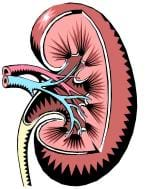
Summary
This lesson helps students explore the functions of the kidney and its place in the urinary system. Students learn how engineers design instruments to help people when kidneys are not functioning properly or when environmental conditions change, such as kidney function in space.Engineering Connection
Kidneys have a very important function in the human body because they are responsible for filtering out waste. When the kidneys fail, a special machine called a dialysis machine can be used to take over the job of the kidneys by extracting urea and salt wastes from the blood. Engineers designed this machine, and they also designed the systems that allow astronauts to go to the bathroom in outer space.
Learning Objectives
- After this lesson, students should be able to:
- Identify major features of the excretory system.
- Explain the role of the kidney.
- Describe how engineers help people whose kidneys are not working properly.
- Explain how astronauts go to the bathroom in outer space.
Educational Standards
Each TeachEngineering lesson or activity is correlated to one or more K-12 science,
technology, engineering or math (STEM) educational standards.
All 100,000+ K-12 STEM standards covered in TeachEngineering are collected, maintained and packaged by the Achievement Standards Network (ASN),
a project of D2L (www.achievementstandards.org).
In the ASN, standards are hierarchically structured: first by source; e.g., by state; within source by type; e.g., science or mathematics;
within type by subtype, then by grade, etc.
Each TeachEngineering lesson or activity is correlated to one or more K-12 science, technology, engineering or math (STEM) educational standards.
All 100,000+ K-12 STEM standards covered in TeachEngineering are collected, maintained and packaged by the Achievement Standards Network (ASN), a project of D2L (www.achievementstandards.org).
In the ASN, standards are hierarchically structured: first by source; e.g., by state; within source by type; e.g., science or mathematics; within type by subtype, then by grade, etc.
NGSS: Next Generation Science Standards - Science
-
CCC.4.3-5.2.
A system can be described in terms of its components and their interactions.
(Grades 3 - 5)
More Details
Do you agree with this alignment?
-
CCC.8.3-5.6.
Engineers improve existing technologies or develop new ones.
(Grade 4)
More Details
Do you agree with this alignment?
-
CCC.8.3-5.8.
Engineers improve existing technologies or develop new ones to increase their benefits, to decrease known risks, and to meet societal demands.
(Grades 3 - 5)
More Details
Do you agree with this alignment?
International Technology and Engineering Educators Association - Technology
-
Technological advances have made it possible to create new devices, to repair or replace certain parts of the body, and to provide a means for mobility.
(Grades
3 -
5)
More Details
Do you agree with this alignment?
-
Describe how a subsystem is a system that operates as part of another, larger system.
(Grades
3 -
5)
More Details
Do you agree with this alignment?
State Standards
Colorado - Science
-
Human body systems have basic structures, functions, and needs
(Grade
5)
More Details
Do you agree with this alignment?
Introduction/Motivation
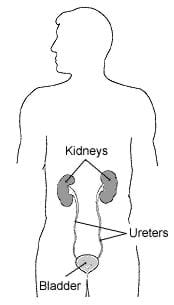
Your kidneys are two truly amazing organs! Today we are going to learn about how engineers help people whose kidneys are not working properly. In addition, we are also going to answer a very important question: how do astronauts go to the bathroom while traveling in outer space?
Kidneys are part of the urinary, or excretory, system in the human body. This is the system that helps us remove waste ─ such as carbon dioxide, salt, excess minerals, toxins, and unused water ─ from our bodies. The excretory organs include the lungs, kidneys, liver and skin, but today, we are going to focus only on the kidneys (see Figure 2). Most people have two kidneys, which are located near the lower back, and protected by the lower ribs. They are bean-shaped, and about the size of your fist. (Have students make a fist.) The other parts of the body that work with the kidneys are the ureters, urethra, bladder, adrenal glands, renal veins and renal arteries. The kidneys are basically hard-working filters. They filter the blood in our body and remove waste substances that our body does not need. If one kidney is damaged, the remaining kidney can do the work for both. Urine is a fluid made by the kidneys that contains the waste substances from the blood. Urine empties out of the kidneys into our bladders, and then eventually, leaves our bodies when we urinate (go to the bathroom).
Engineers, especially biomedical engineers, have done a lot to help people who have problems with their kidneys. Engineers have designed a machine, called a dialysis machine, which works like an artificial kidney. This device takes a person's blood, filters out the extra salt and wastes, and then returns the clean blood to their body. Engineers have also designed a system to help astronauts go to the bathroom in outer space.
How exactly do astronauts go to the bathroom in space? This is a question that many of you might be curious about. The answer is very interesting and shows how much engineering design work it took to develop a toilet that can be used in space. The toilet used on the space shuttle is called a WCS, which stands for Waste Collection System (see Figure 3). Astronauts need to learn how to use the WCS before they actually travel into space, so they practice here on Earth first on two WCS simulators. One of the simulators has a special camera so they can observe themselves and make sure they are doing everything correctly, and the other simulator is an actual working model.
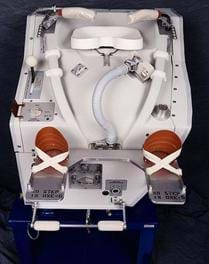
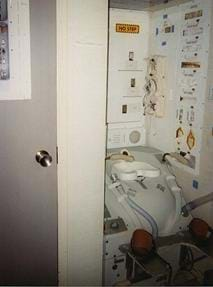
Since there is almost no gravity in space, astronauts must use a special vacuum system to pull their waste into a disposal system. Also, the astronauts need to have restraints to help them stay seated or standing. There are toe holds, a thigh restraint bar, and Velcro® straps that keep the astronauts from floating away while they use the WCS (see Figure 4). Also, the air in the bathroom can get rather smelly, so engineers designed special fans and filters to remove bacteria and odors so that the space station does not get smelly.
Today we are going to learn a little bit more about how kidneys work and how engineers need to understand this before they can design helpful instruments like dialysis machines and toilets for astronauts.
Lesson Background and Concepts for Teachers
The human body has many methods for cleansing itself. Carbon dioxide is released from the body by exhaling, salt is released through sweat, and food waste as feces. The body also cleanses itself by releasing excess minerals, toxins, and unused water through the urinary (or excretory) system in the form of urine.
The kidney is the main organ in the urinary system. Most people have two kidneys, which are located near the lower back, and protected by the lower ribs. They are bean-shaped, and about the size of a fist. The other parts of the urinary system are the ureters, urethra, bladder, adrenal glands, renal veins and renal arteries. The kidneys play a key role in this system, acting as filters for the blood. The basic cleaning unit within the kidney is called the nephron, which is made up of capsules, tubules, and blood vessels. Each kidney has about one million nephrons!
The renal arteries bring the blood into the kidney to be cleaned (see Figure 5). The blood is pumped through little bunches of blood vessels, or capillaries, called glomeruli. These little bunches of glomeruli are located inside nodules called Bowman's capsules. There is a small amount of space between the glomeruli and the walls of the capsules. Excess salts, minerals, and toxins pass through the walls of the capillaries in the glomerulus, then through the porous walls of the capsule and into the proximal tubule. All of this occurs inside the cortex, the outer portion of the kidney.
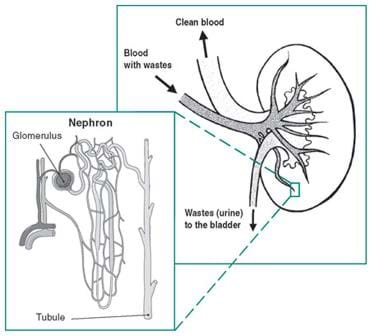
The proximal tubule moves the waste from the cortex and through the medulla (inner portion of the kidney) in a u-shaped loop known as the Henle loop. This long passage allows water and needed minerals to be reabsorbed. Renal veins take the cleansed blood back into the rest of the body.
The proximal tubules drain the remaining waste into the collecting ducts. The collecting ducts move waste materials, in liquid form, out of the kidney and into the ureters, which are tubes connecting the kidney and bladder. The ureters move the waste products, allowing one more opportunity for the body to reabsorb water and needed nutrients, before finally dumping into the bladder.
The bladder fills up with waste material, much like a balloon on the end of a faucet. As the bladder expands, it places pressure on the sensors in its lining that trigger the need to urinate. When the body releases its hold on the bladder, the waste products travel along the urethra and are expelled from the body.
When the kidney fails due to disease or accident, a dialysis machine can be used to take over the job of the kidneys. Blood is taken from an artery and passed through the machine, which filters the blood much like the kidney does. Dialysis patients generally must spend several hours at least three times a week on a dialysis machine. (See the associated activity, Kidney Filtering, for more details on how dialysis machines work.)
Associated Activities
- Kidney Filtering - In this activity, students create a hands-on filtering system to demonstrate the function of the kidney.
Lesson Closure
As we learned today, the kidneys are an important organ in the body. They help us remove waste substances that our body does not need. Who remembers which body system the kidneys belong to? That's right, the urinary or excretory system! How do kidneys remove waste for us? They filter the harmful waste substances in the blood, leaving the blood with only good substances. The waste substances are moved through the rest of the body in water, stored in the bladder, and eventually removed from our bodies in urine.
Can people live with only one kidney? Yes, and many people do! Engineers have designed a dialysis machine, which helps people when their kidneys are not functioning. It works like an artificial kidney. It takes a person's blood from their body, filters out the extra wastes, and then returns the clean blood back to their body.
Engineers have also designed a special toilets and bathrooms to help astronauts go to the bathroom in outer space. Who remembers what it is called? Yes, the WCS or Waste Collection System. How does it work? Astronauts must use a special vacuum system to pull their waste into a disposal system. Also, the astronauts need to have restraints to help them stay seated or standing.
We may not realize how much thought and engineering design has to happen in order to send an astronaut into space. Engineers need to learn how each of the human body systems function and then design the space environment to help keep each of those body systems healthy and functioning properly while astronauts travel to space.
Vocabulary/Definitions
Adrenal Gland: A gland that sits on top of each kidney and produces hormones.
Bladder: The sack in the lower abdomen that holds urine.
Bowman's Capsule: A small nodule of tissue consisting of an outer wall and a small bunch of capillaries bunched together inside separated by a space; functions as a part of the filtering system, allowing wastes to pass through the walls of the capillaries and into the proximal tubule; named for William Bowman.
Collecting Duct: Tubes inside the kidneys that collect waste products from the rest of the filtering system and move the wastes into the ureter.
Dialysis: The process of separating substances in solution by diffusion through semipermeable membranes; hemodialysis refers specifically to purifying blood by dialysis.
Excretory System: The system made up of bladder, kidneys and connecting tubes that cleans the blood and excretes waste from the body (also called the urinary system).
Glomerulus: Small bunches of blood vessels or capillaries inside each Bowman's capsule that act as waste expulsion stations for salts, minerals and other waste products expelled from the blood stream.
Henle Loop: U-shaped loop in the proximal tubule that slows the passage of waste to allow re-absorption of water.
Nephron: The filtering unit inside the kidney used to filter impurities and waste from the blood.
Proximal Tubule: A tube connecting glomerulus to collecting ducts within the kidney.
Renal Artery: The main artery that brings blood into the kidney to be cleaned.
Renal Vein: The main vein that takes cleaned blood out of the kidney and back to the heart.
Ureters: Tubes connecting the bladder and the kidney.
Urethra: The exit tube from the bladder.
Urinary System: The system made up of bladder, kidneys and connecting tubes that cleans the blood and excretes the waste from the body (also called the excretory system).
Urine: Liquid waste expelled from the body.
Assessment
Pre-Lesson Assessment
Brainstorming: As a class, have the students engage in open discussion. Remind students that in brainstorming, no idea or suggestion is "silly." All ideas should be respectfully heard. Take an uncritical position, encourage wild ideas and discourage criticism of ideas. Have them raise their hands to respond. Write their ideas on the board. Ask the students:
- What might an engineer have to consider about helping astronauts go to the bathroom in space?
Post-Introduction Assessment
Question/Answer: Ask the students questions and have them raise their hands to respond.
- What system of the body do the kidneys belong to? (Answer: Excretory or urinary system)
- Who knows where your kidneys are located? (Answer: Point to the sides of your lower back.)
- What do your kidneys do? (Answer: They work as a filtering system, removing waste from the body.)
- How many kidneys do you have? (Answer: Most people have two, but some people have only one.)
- Can you live with only one kidney? (Answer: Yes, if one kidney is damaged or removed, the other kidney can do the work of two.)
- What two devices did engineers design that we are going to further learn about today? (Answer: Dialysis machine and space shuttle bathroom system for astronauts.)
Lesson Summary Assessment
Engineering Application: Blood and waste flow through the excretory system in a pattern. How do we usually represent how something flows though a system? We use arrows to show the direction of flow. For example, when we learn about the water cycle, we use arrows to show how water moves through the water cycle. Engineers are very interested in how things flow. Engineers often trace the path of flow and can use something called "flow charts" to plan many different things: management charts, scheduling, flow of a product through a factory, flow through a dialysis machine, etc. Can you think of other examples where engineers might want to know about flow and in what direction something is flowing? (Possible answers might include: flow of water though pipes in a house, flow of air through a building, flow of energy through a power line, etc.)
Kidney Walkthrough (Formation): If time permits, draw a large scale drawing of the kidneys and excretory system with chalk outside. Then, as a class, go out to the diagram and take turns walking through the drawing while explaining how the different parts work and how the system as a whole functions.
Lesson Extension Activities
Assist students in researching one of the following scientists or topics:
- William Bowman (1816-1892) – English surgeon who discovered capsules
- Marcello Malpighi (1628-1694) – pioneer microscopist
- Urine composition and health
- Kidney diseases and treatments
- Nutrition and kidney function
- Design of dialysis machines
Ask students to draw a flow chart of how blood moves from the renal artery through the liver, detailing where the wastes are deposited, how they are expelled from the body, and what happens to the cleaned blood.
Subscribe
Get the inside scoop on all things TeachEngineering such as new site features, curriculum updates, video releases, and more by signing up for our newsletter!More Curriculum Like This

Students filter different substances through a plastic window screen, different sized hardware cloth and poultry netting. Their models show how the thickness of a filter in the kidney is imperative in determining what is filtered out and what stays in the blood stream.

This lesson describes how the circulatory system works, including the heart, blood vessels and blood. Students learn about the chambers and valves of the heart, the difference between veins and arteries, and the different components of blood.
References
Bock, Glenn H., et all. 1993. A Parent's Guide to Kidney Disorders. Minneapolis: University of Minnesota Press.
Brooks, Dawn. National Aeronautics and Space Administration (NASA), Office of Space Operations, Space Operations Mission Directorate, Q&A, "Space Flight Questions and Answers," June 1, 2005. http://www.nasa.gov Accessed May 24, 2006
Burnie, David. 1995. The Concise Encyclopedia of the Human Body. New York: Dorling Kindersley Limited, pp. 126-127.
Clark, John, ed. 1985. The Human Body: The Kidneys, Balancing the Fluids. New York: Torstar Books, Inc.
Clayman, Charles M.D., ed. 1995. The Human Body: An Illustrated Guide to its Structure, Function, and Disorders. New York: Dorling Kindersley Limited, pp. 175-180.
Dismukes, Kim. National Aeronautics and Space Administration, Human Space Flight, Behind the Scenes: Engineering, "Facilities and Projects," July 10, 2003. spaceflight.nasa.gov Accessed May 24, 2006
Dismukes, Kim. National Aeronautics and Space Administration, Human Space Flight, Human Space Flight, "Waste Collection System," April 7, 2002. spaceflight.nasa.gov Accessed May 24, 2006
Elting, Mary. 1986. The Macmillan Book of the Human Body. New York: Macmillan Publishing Company, pp. 42-44.
Galan, Mark. 1992. Time-Life Series. Understanding Science and Nature: Human Body. Alexandria, VA: Time-Life Books, Inc., pp. 94-96.
Glabman, Sheldon M.D. 1976. Your Kidneys, Their Care and Their Cure. New York: E. P. Dutton & Co.
Keith, Lori. National Aeronautics and Space Administration, NASA Quest, Field Journal Index, "Going to the Bathroom in Space," May 25, 1998. quest.arc.nasa.gov Accessed May 19, 2006
Keith, Lori. National Aeronautics and Space Administration, NASA Quest, Field Journal Index, "Going to the Bathroom in Space," May 25, 1998. quest.arc.nasa.gov Accessed May 19, 2006
Llamas, Andreu. 1998. The Human Body: Digestion and Reproduction. Milwaukee, WI: Gareth Stevens Publishing, pp. 16-19.
National Aeronautics and Space Administration (NASA), Lyndon B. Johnson Space Center, NASA Facts, Benefits from Apollo: Giant Leaps in Technology, FS-2004-07-002-JSC, July 2004. quest.arc.nasa.gov Accessed May 24, 2006
National Aeronautics and Space Administration (NASA), National Center for Aerospace Information, Scientific and Technical Information, "Apollo's Contributions to America, October 21, 2005. www.sti.nasa.gov Accessed May 24, 2006
National Kidney Foundation, A to Z Health Guide, "Your Comprehensive Guide to Kidney Disease and Related Conditions," www.kidney.org/atoz/index.cfm Accessed May 24, 2006
The Nemours Foundation, Kids Health, "What Kids Need to Know About Kidneys," kidshealth.org Accessed May 24, 2006
Parker, Steve. 1993. Eyewitness Science: The Human Body. New York: Dorling Kindersley Limited, pp. 38-40.
Reid, Des, ed. 1996. The Visual Dictionary of Human Anatomy . New York: Dorling Kindersley Limited, pp. 24, 42 and 46.
Rowan, Pete. 1995. Some Body! New York: Alfred A. Knopf, pp. 29, 24-25.
Schwab, Steve J. 1997. Eating Well with Kidney Disease. New York: Viking Press.
Silverstein, Alvin, et all. 1994. The Excretory System. New York: Twenty-First Century Books.
U.S. Department of Health and Human Services, National Institutes of Health, National Institute of Diabetes and Digestive and Kidney Diseases, National Institutes of Health, National Kidney and Urologic Diseases Information Clearinghouse (NKUDIC), NIH Publication No. 06–4241, November 2005, "Your Kidneys and How They Work," kidney.niddk.nih.gov Accessed May 19, 2006
U.S. Department of Health and Human Services, National Institutes of Health, National Institute of Diabetes and Digestive and Kidney Diseases, National Institutes of Health, National Kidney and Urologic Diseases Information Clearinghouse (NKUDIC), NIH Publication No. 03–4666, September 2003, "Treatment Methods for Kidney Failure: Hemodialysis," kidney.niddk.nih.gov Accessed May 19, 2006
U.S. Department of Health and Human Services, National Institutes of Health, National Institute of Diabetes and Digestive and Kidney Diseases, National Institutes of Health, National Kidney and Urologic Diseases Information Clearinghouse (NKUDIC), NIH Publication No. 06–4241, November 2005, "Kidney Failure Glossary," kidney.niddk.nih.gov Accessed May 19, 2006
U.S. Department of Health and Human Services, National Institutes of Health, National Institute of Diabetes and Digestive and Kidney Diseases, National Institutes of Health, National Kidney and Urologic Diseases Information Clearinghouse (NKUDIC), NIH Publication No. 06–4281, March 2006, "Prevent Diabetes Problems: Keep Your Kidneys Healthy," diabetes.niddk.nih.gov Accessed May 24, 2006
U.S. National Cancer Institute's Surveillance, Epidemiology and End Results (SEER) Program, Training Website, "Functions of the Urinary System."
Copyright
© 2006 by Regents of the University of Colorado.Contributors
Jessica Todd; Emily Weller; Sara Born; Abigail Watrous; Denali Lander; Malinda Schaefer Zarske; Janet YowellSupporting Program
Integrated Teaching and Learning Program, College of Engineering, University of Colorado BoulderAcknowledgements
The contents of this digital library curriculum were developed under a grant from the Fund for the Improvement of Postsecondary Education (FIPSE), U.S. Department of Education and National Science Foundation GK-12 grant no. 0338326. However, these contents do not necessarily represent the policies of the Department of Education or National Science Foundation, and you should not assume endorsement by the federal government.
Last modified: March 12, 2022







User Comments & Tips